Biding my Time
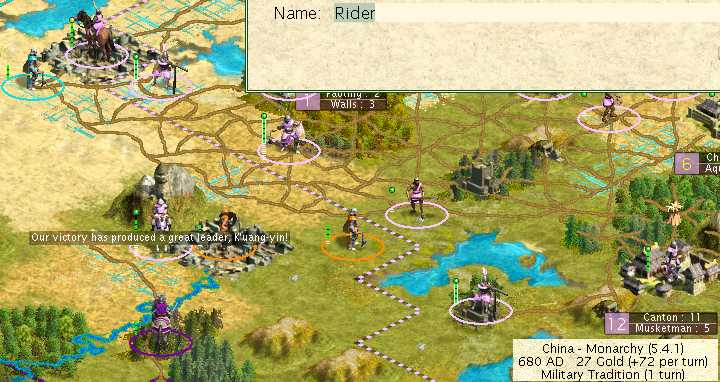
Leader 11 pops in 680 AD. Shanghai doesn't have anything to rush with him - it's already halfway done building towards the Military Academy which is the only culture available and I don't want to save him six turns until Bach's. So he hurries a university in Chinan, my highest-commerce city without one. Leaders 12 and 13 also came in the next couple turns, and also rushed universities in various places.
By 700 AD, the AIs have acquired both Metallurgy and Banking; not good, I want that tech to go slower. I had been planning to research Music Theory at first-civ after getting Military Tradition, but I changed my mind and researched a devalued Banking in 4 turns with a surplus.
In 760 AD, the AIs have acquired two more techs: Astronomy and Printing Press. Also this turn I notice that the Iroquois have been the first civ to drop out of Republic. I begin research on Astronomy, due in 4 turns at 60% science and -10 gold/turn. Shanghai has 5 turns to go on the Military Academy build; very conveniently I can turn that into Copernicus instead.
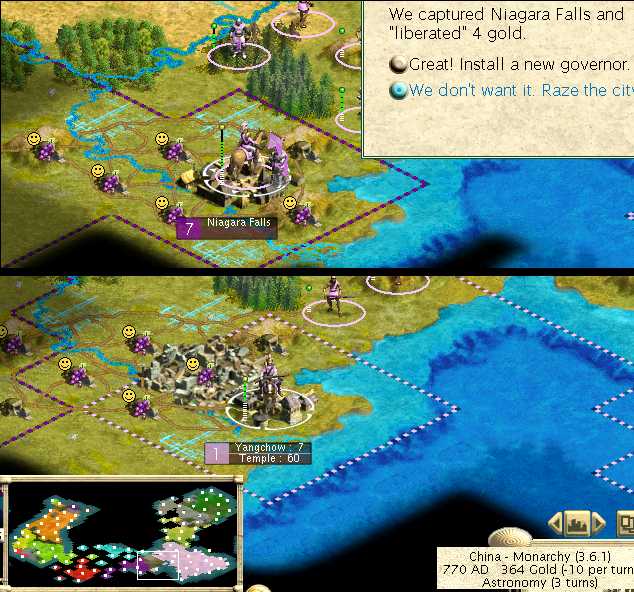
770 AD sees my first capture of a rival's core city. I brought two armies to do the job, but the city only even had two defenders. It gets razed and replaced, and having my own Wines online (four lux total) lets me drop the luxury tax to zero. I still need a handful of entertainers in cities that didn't build marketplaces, but I hope to get JS Bach's Cathedral soon that will eliminate even that.
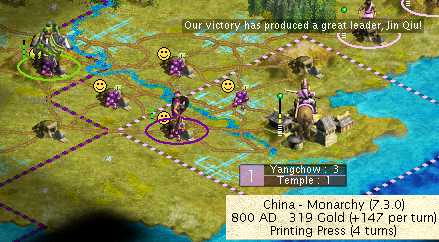 790 AD brings a very unwelcome sight: Persian cavalry. Two kill my cavalry army that was left exposed. At least one brought me a leader when defeating it; he rushes the Military Academy in Shanghai a turn after the city completes Copernicus. And yes, I'm researching Printing Press in the push up to Shakespeare's. Bet that doesn't happen often in Always War.
790 AD brings a very unwelcome sight: Persian cavalry. Two kill my cavalry army that was left exposed. At least one brought me a leader when defeating it; he rushes the Military Academy in Shanghai a turn after the city completes Copernicus. And yes, I'm researching Printing Press in the push up to Shakespeare's. Bet that doesn't happen often in Always War.
Leader 15 comes on the northern front in 810 AD, and forms another army to fill with Cavalry. I should have realized earlier that this would happen, but all three civs to the north (Japan, Mongolia, and India) have knight-based UUs, and despite my efforts, all three have recorded victories with them and gotten their Golden Ages. So I'm happy to keep this front right where it is; I'm not trying to advance here, not for some time yet, and I wouldn't until artillery. I'm happy to minimize casualties with the two armies and let the brunt of my force keep going towards the Iroquois. Here's what that northern front looked like. My cities are in great locations for visibility right up to the edge of the jungle, and there's a WIDE strip of flatland in which to kill incoming units. And note the "what can wait" rule still applying - that MDI and elephant are clearly in the category of no need to kill them this turn.
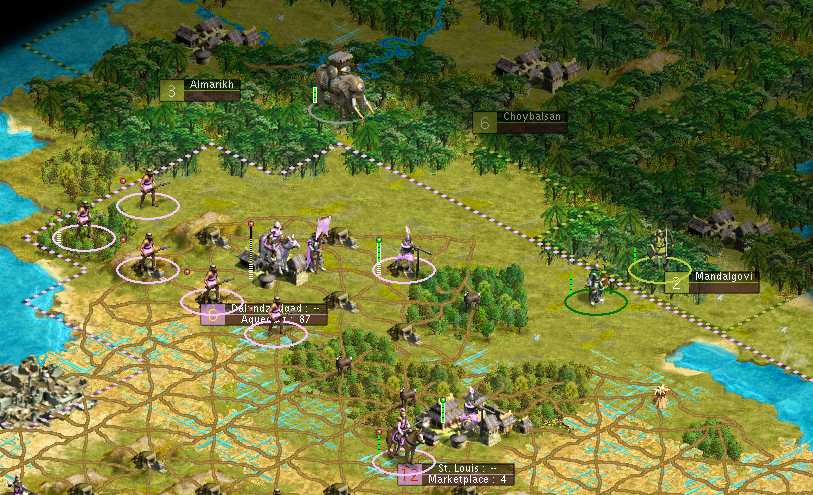
Leader 16 also comes in 810 AD, my first double-dip on the same turn, and he goes for a university in St. Louis.
After Printing Press, the AIs have acquired Economics, and I follow on that research because I do want Smith's Trading Company. This tech also comes in 4 turns, with over +100 per turn surplus. That economic backbone of my China is really holding up well, and that press to build the Universities is making a big difference too.
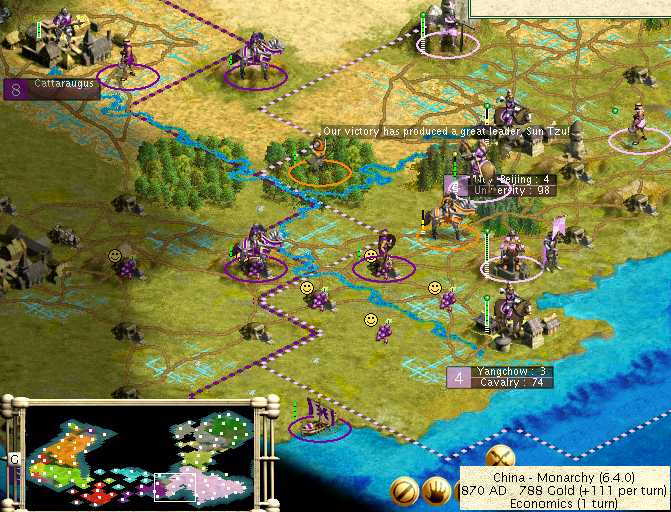
Leader 17 arrives in 870 AD, at the perfect time to go rush Smith's in Shanghai.
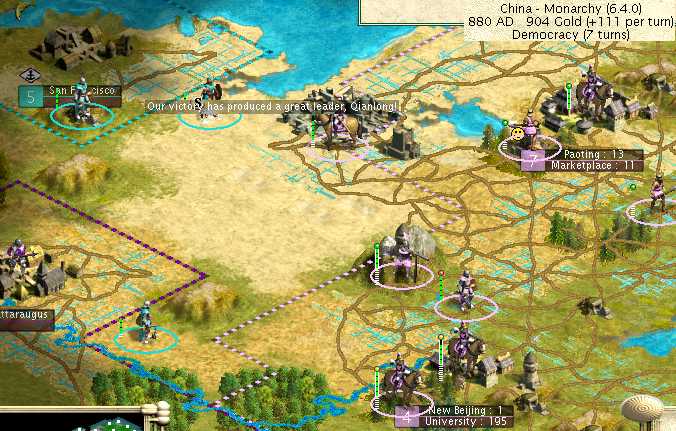
Leader 18's birthday is the next turn. He forms an army, since I've now got two Elite* cavalry in the area to load into it.
Yes, that mountain's got an Outpost on it. Outposts are useless on lowland and hills - they don't extend your visibility at all there. But on a mountain, they do give you a third tile of visibility, so I put them on mountains in the border zones whenever I got a chance. That mountain there overlooks that VAST desert. I can see units coming a hundred miles away, and charge out with cavalry in this killing zone non pareil.
Also, I discovered a fair bit about how mixed armies work in this game. My original army had a swordsman, archer, and spear in it; and after the Pentagon was built I put a musketman into it because I didn't need that army for offense any more, but it was useful on defense.
The way mixed armies work is this: when you attack, the game uses the best offensive unit in the army to attack. That unit will attack, using its own stats, not the mixed (averaged) stats that the game shows for the army. If that unit loses as many hit points as its experience level would indicate, it retreats and the next best offensive unit takes over, and so on. The converse occurs on defense, with the best defensive unit fighting until it loses its allocation of HP, then the next best, and so on.
In my mixed army here, the swordsman would always lead off when attacking, with an attack strength of 3. He was Elite*, so he had 5 HP to spend. If the army lost 5 HP while he was attacking, the Elite* archer took over, now attacking at only 2 strength, and the difference in HP damage inflicted on the enemy was noticeable. If the army then lost another 5 HP, the veteran musket would start attacking. If THAT unit still lost another 4 HP - still in the same fight - finally the spearman would begin attacking. Only once did that happen to me, and luckily the spearman did manage to win instead of the army getting killed.
This means that mixed armies can be of much use in the early game. Every time the army attacks, it does so with a fresh batch of HP assigned to the leading unit; the entire process is repeated anew for each combat. Even if my 14-HP army lost 6 HP attacking on one turn, the next turn the army could attack again and the swordsman would have five fresh shots with attack strength of 3, without needing to heal inbetween. Basically, the swordsman could draw on the HP of the spearman and use it for strength-3 attacks. The same thing can happen on defense, with the musket getting a full 5 HP worth of strength-4 defense even against multiple attacks on the same turn (although the AI almost never attacked the army.)
Here's a clearer example of what happens. Suppose you filled an early army with three horsemen, then load a knight into the army after building the Pentagon. When the army attacks, it will do so at 4 strength; and can make TWO attacks in the same turn BOTH at strength 4 using only ONE knight, since the knight will get a fresh allocation of the army's HP assigned to it for the second attack.
Promotions are assigned based on whatever unit is currently doing the attacking or defending when the army wins the battle. This is why it is VERY hard to get a 19-HP army promoted to 20. For that to happen, the first three elite attackers all need to exhaust their 5 HP allocations, then the last veteran must win while the army has 4 HP or less remaining.
There is some weirdness when the army gets very weak, with the game switching active units in the army frequently during the army's last 3 or 4 HP. The best guess I can make is that each unit is guaranteed to have at least one HP assigned to it; attack with a 4-HP army and the best attacking unit will only attack until it loses 1 HP. But however that works, you can't really make use of it in combat.
Anyways, it's time for a report on the state of the AIs. America has been in bad shape for a long time (never having had a Golden Age), and appear to not have horses, so all I'm seeing is a trickle of MDI that are easily slaughtered by cavalry. The Iroquois aren't doing too well either, with half their core gone already. My three northern neighbors of the Mongols, Japan, and India can't dent me, and with my cannons and armies I'm enjoying a kill ratio against them of ten-to-one or better.
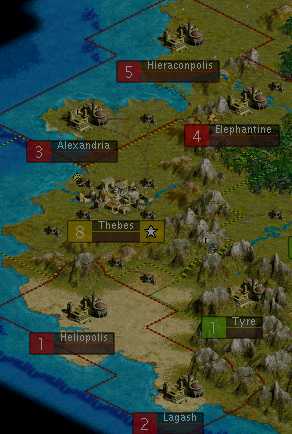 Egypt and Babylon had been at war with each other for a while, possibly since before I contacted the civilizations. Because of this, very few Egyptian and Babylonian units have come my way - Egypt isn't even furious with me yet! However, somewhere in here I get a rude surprise in the form of three Babylonian cavalry suddenly appearing. That plus the fact that Egypt had been down to Thebes for about 10 turns, but hasn't lost it yet, leads me to conclude that those two civs made peace. (I don't know because I wasn't able to found any embassies, having gotten all the contacts and declared the wars before getting Writing myself.)
Egypt and Babylon had been at war with each other for a while, possibly since before I contacted the civilizations. Because of this, very few Egyptian and Babylonian units have come my way - Egypt isn't even furious with me yet! However, somewhere in here I get a rude surprise in the form of three Babylonian cavalry suddenly appearing. That plus the fact that Egypt had been down to Thebes for about 10 turns, but hasn't lost it yet, leads me to conclude that those two civs made peace. (I don't know because I wasn't able to found any embassies, having gotten all the contacts and declared the wars before getting Writing myself.)
That leaves the Ottomans and Persians, who are in very good shape and have most firmly been the research leaders in this game. They're going to be the hardest nuts to crack later on, and in the meantime the Persian cavalry and especially Ottoman Sipahi are going to cause me some headaches.
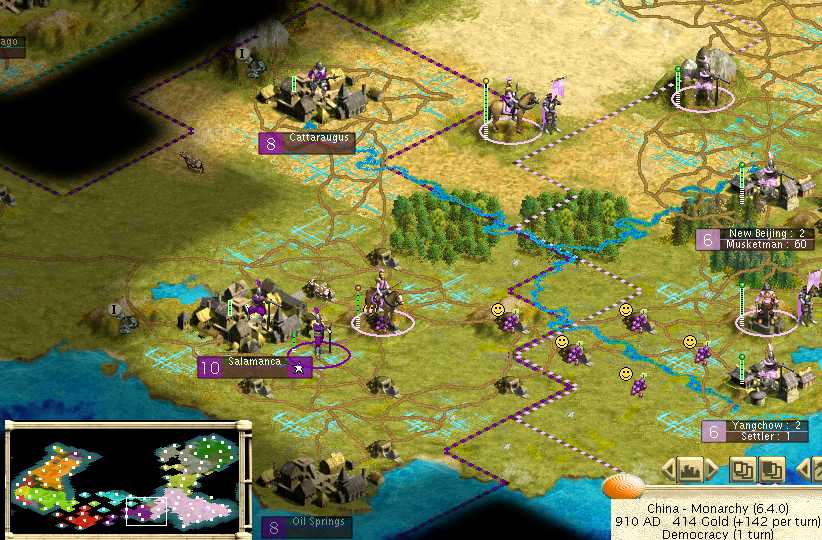
Here's where I move in and gut the Iroquois core. Or so I thought. Cattaraugus fell easily, but Salamanca had at least five muskets in it and repelled that cavalry invasion. Well, the Iroquois don't have saltpeter, so as long as I mass up some more cavalry (and use the armies) before they get Nationalism, I'll be fine.
And, yes, I was researching Democracy (not at first-civ, of course.)
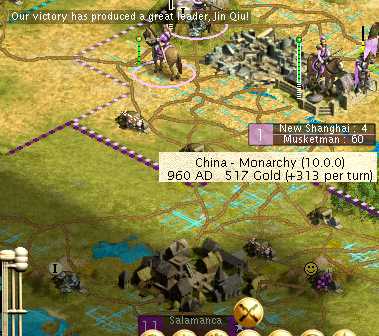 Leader Nineteen pops in 960 AD. And now an interesting situation is taking place: I've got competition on a wonder for the first time this game. For whatever reason, half of the AIs started building Shakespeare's Theater after not even attempting any other Middle Ages wonder.
Leader Nineteen pops in 960 AD. And now an interesting situation is taking place: I've got competition on a wonder for the first time this game. For whatever reason, half of the AIs started building Shakespeare's Theater after not even attempting any other Middle Ages wonder.
Democracy finished in 920 AD; next I researched Music Theory which finished in 960 AD. So I'm still four turns away from researching Free Artistry. What I did with this Leader was to set Shanghai to build an army (400 shields), rush that with the leader, then swap the city to the Palace. I wanted to use up this Leader (so I could get another), and leave the shields sitting in Shanghai's box ready to build Shakespeare's as soon as I got the tech, then do JS Bach's with the next Leader.
I wanted to do that convolution because of competition for the wonders. I wanted to build the cheaper wonder first, giving me more time to get another Leader for the 600-shield wonder before one of the AI cities accumulated enough shields for it. India is in Golden Age and Delhi has a lot of shield potential in its terrain.
The only problem was this: it didn't work! Rushing something with a Leader counts as hurrying production, after which you can't swap to a wonder (from the army to the Palace). I had no idea.
So I reloaded the autosave (that was the first thing I did on the turn), and simply rushed Bach's with the GL. I had to hope I'd get another GL before anyone completed the Shake...
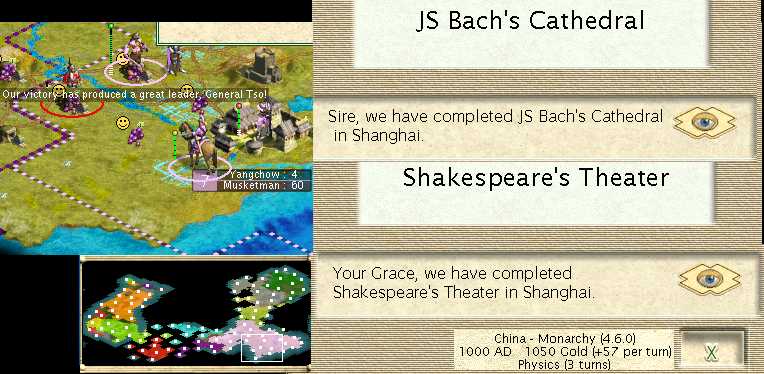
but the game obliged.
In 1030 AD, F4 shows India into the Industrial Age, while I'm one turn away from Physics. Then in 1040 AD, thanks to a full-powered 20/20 cavalry army and good cannon shooting, I capture my first AI capital.
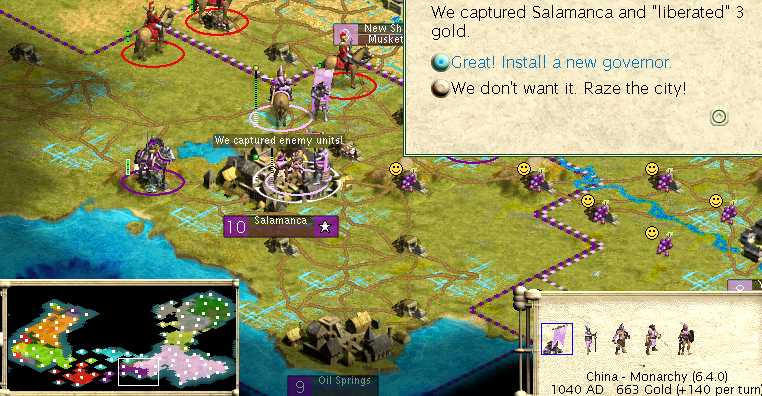
Leader 21 pops in 1070 AD, and in 1080 AD I have a decision to make. It's time for a new Palace, to get two full cores producing at full capacity rather than about one-and-a-half. I've been preparing for this by having all the cities in Beijing's area make sure they have courthouses in place, and by ramping up the population as best I can in the New Shanghai-New Beijing area so they'll be ready to go once the new Palace is ready. It takes me a while, but I decide to go ahead and put the new Palace way out in New Shanghai for better long-term productivity, rather than in New Beijing which would keep Canton, Chengdu, and St. Louis more productive but take away several more productive city slots in the west.
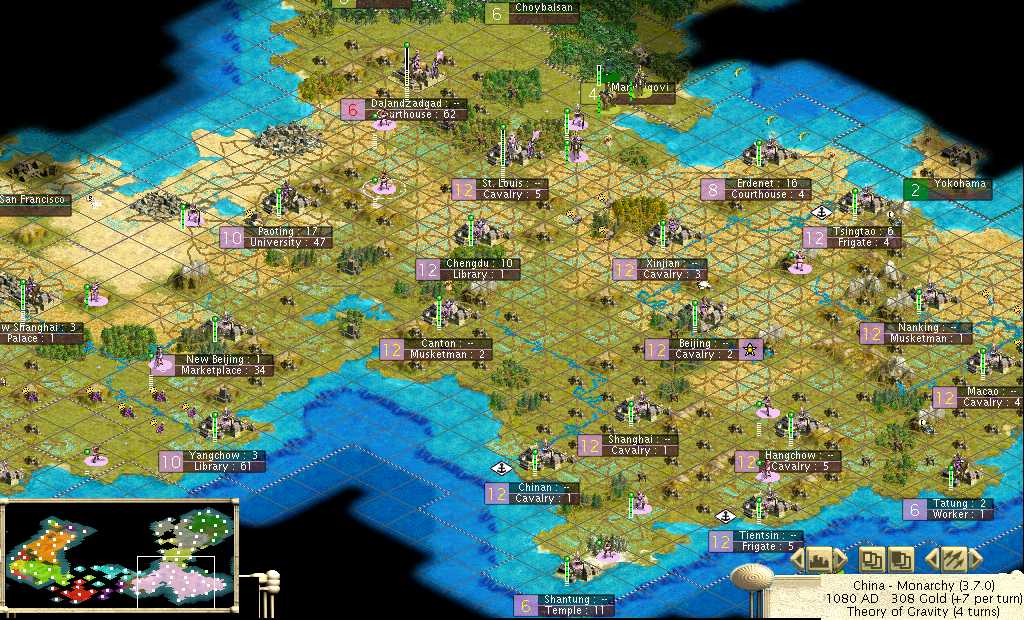
I can just fit the Palace and Forbidden Palace sites in that picture. New Shanghai is the former and Macao is the latter. That's two-plus full rings around each site, which should be the production advantage I'll need to bring this one home.
Index | Next
 790 AD brings a very unwelcome sight: Persian cavalry. Two kill my cavalry army that was left exposed. At least one brought me a leader when defeating it; he rushes the Military Academy in Shanghai a turn after the city completes Copernicus. And yes, I'm researching Printing Press in the push up to Shakespeare's. Bet that doesn't happen often in Always War.
790 AD brings a very unwelcome sight: Persian cavalry. Two kill my cavalry army that was left exposed. At least one brought me a leader when defeating it; he rushes the Military Academy in Shanghai a turn after the city completes Copernicus. And yes, I'm researching Printing Press in the push up to Shakespeare's. Bet that doesn't happen often in Always War.




 Egypt and Babylon had been at war with each other for a while, possibly since before I contacted the civilizations. Because of this, very few Egyptian and Babylonian units have come my way - Egypt isn't even furious with me yet! However, somewhere in here I get a rude surprise in the form of three Babylonian cavalry suddenly appearing. That plus the fact that Egypt had been down to Thebes for about 10 turns, but hasn't lost it yet, leads me to conclude that those two civs made peace. (I don't know because I wasn't able to found any embassies, having gotten all the contacts and declared the wars before getting Writing myself.)
Egypt and Babylon had been at war with each other for a while, possibly since before I contacted the civilizations. Because of this, very few Egyptian and Babylonian units have come my way - Egypt isn't even furious with me yet! However, somewhere in here I get a rude surprise in the form of three Babylonian cavalry suddenly appearing. That plus the fact that Egypt had been down to Thebes for about 10 turns, but hasn't lost it yet, leads me to conclude that those two civs made peace. (I don't know because I wasn't able to found any embassies, having gotten all the contacts and declared the wars before getting Writing myself.)
 Leader Nineteen pops in 960 AD. And now an interesting situation is taking place: I've got competition on a wonder for the first time this game. For whatever reason, half of the AIs started building Shakespeare's Theater after not even attempting any other Middle Ages wonder.
Leader Nineteen pops in 960 AD. And now an interesting situation is taking place: I've got competition on a wonder for the first time this game. For whatever reason, half of the AIs started building Shakespeare's Theater after not even attempting any other Middle Ages wonder.

